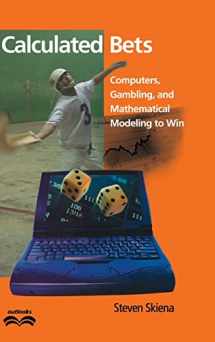
Calculated Bets: Computers, Gambling, and Mathematical Modeling to Win (Outlooks)
Book details
Summary
Description
Amazon.com Review
You could just as easily call this book How to Bet at Jai-Alai and Win! But that's only half the story. While Calculated Bets might indeed help you make a buck down at the fronton, it's as much concerned with the power of mathematical modeling and computer programming. The story of accomplished mathematician Steven Skiena's longtime obsession with this obscure Basque sport, Calculated Bets uses straightforward mathematics and real-world examples to divine the statistical mysteries behind playing--and, more important, wagering on--jai alai. (Which goes a long way toward explaining why Cambridge University Press is publishing what's basically a book about gambling.)
A self-styled "mild-mannered professor," the conversational Skiena (The Algorithm Design Manual) delivers on his book's many promises, from explaining how mathematical models are "designed, built, and validated" to providing lucid discussions of such topics as market efficiency and the difference between correlation and causation. Even better are his riffs on why real programmers hate Microsoft (hint: it's not jealousy) and the beauty behind interesting curves. In the end, Skiena even puts his money where his mouth is: using a modem, he sets loose an auto-dialing program called Maven that he and his grad students cooked up, sending it off in the wee hours of the morning to cull the Web for stats, play each match a half-million times, and then automatically wager a $250 stake. --Paul Hughes
Calculated Bets describes a gambling system that works. Steven Skiena, a jai-alai enthusiast and computer scientist, documents how he used computer simulations and modeling techniques to predict the outcome of jai-alai matches and increased his initial stake by 544% in one year. Skiena demonstrates how his jai-alai system functions like a stock trading system, and includes examples of how gambling and mathematics interact in program trading systems, how mathematical models are used in political polling, and what the future holds for Internet gambling. With humor and enthusiasm, Skiena explains computer predictions used in business, sports, and politics, and the difference between correlation and causation. An unusual presentation of how mathematical models are designed, built, and validated, Calculated Bets also includes a list of modeling projects with online data sources. Steven Skiena, Associate Professor of Computer Science at SUNY Stony Brook, is the author of The Algorithm Design Manual (Springer-Verlag, 1997) and the EDUCOM award-winning Computational Discrete Mathematics. He is the recipient of the ONR Young Investigator's Award and the Chancellor's Award for Excellence in Teaching at Stony Brook. His research interests include discrete mathematics and its applications, particularly the design of graph, string, and geometric algorithms.


We would LOVE it if you could help us and other readers by reviewing the book
Book review



